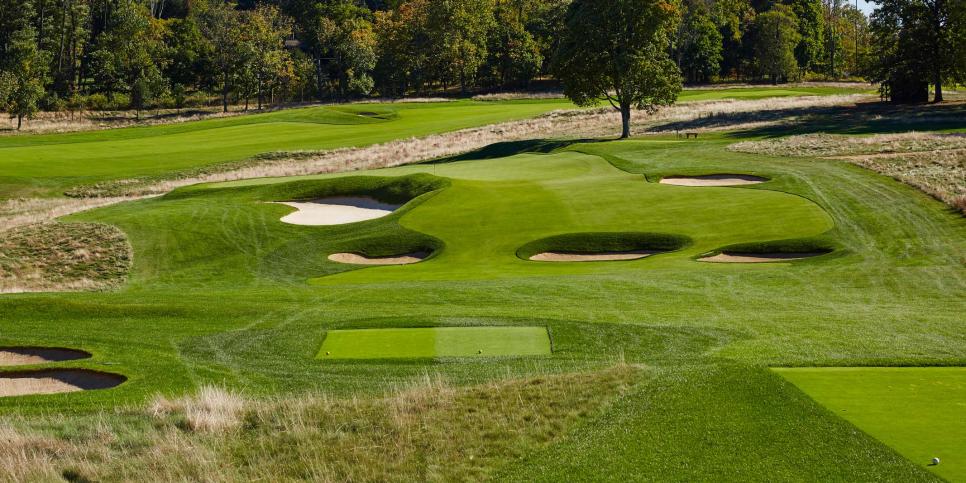
Even if you’re not a golf architecture junkie, you’ve probably heard of a “Redan” hole. A Redan refers to the shaping and orientation of the green, typically narrow and angled away from the tee, its middle guarded by a bunker and the putting surface falling from front to back either entirely or in its back half.
Though most often par 3s, there are par 4s and 5s that possess Redan-style greens. But the fact that golfers and writers never miss an opportunity to label these kinds of holes by their proper name gives the impression that Redans are in some way special, or extra, the way a sweater is not just a sweater if it’s a cashmere sweater, and a Michelin-starred restaurant is more than just an ordinary restaurant.

George C. Thomas built his rendition of a Redan hole at Riviera Country Club, where the fourth hole still tests the best players in the world today. Ben Hogan called it "the greatest par 3 in America."
Carlos Amoedo
Redans can indeed be special holes, but because the label is so readily applicable it’s often given, generically, to any par 3 with an angled green or some part of a putting surface that’s canted. The true test of a Redan, however, is not only its shape but in the way it plays.
HOW TO PLAY IT
The most memorable Redans present strategic opportunities not common in one-shot holes. Depending on the flag location, the firmness of the ground and the wind conditions, the choice of how to approach them can be perplexing.
Carrying the ball onto the green and holding it demands unerring distance control and spin, and even then this option is usually a foolish one given the lack of depth and tilt of the landing surface. Aiming short of the green or at the front quarter, either with a high shot or low chasing runner, is the historically correct way to play the hole, but counting on the ball to coast all the way toward back and middle pins can be an act of faith. And missing the green either short or over is usually disastrous.

Derek Duncan
BRIEF HISTORY
The Redan takes its name from military fortifications popular in the 18th century. The predominant feature was an angular abutment protruding from a high wall, giving the defenders a range of coverage to the left and right.
In golf, the front corner of the green represents the lunette, or protrusion, with the rest of the putting surface obscured from visibility as it extends back. Legend has it the name was first applied to what is today the 15th hole at North Berwick in Scotland when a veteran of the Crimean war noticed its resemblance to a fortress in Sebastopol.
The most famous Redan after North Berwick’s 15th is the fourth at National Golf Links of America, opened in 1911 and built by C.B. Macdonald. This was the first manufactured variation of the original (it was not an exact replica), and its excellence was such that Macdonald would continue to build versions of the hole at each course he designed thereafter. So would Macdonald’s surveyor and construction engineer, Seth Raynor, at the nearly 50 courses he designed on his own, and so too would Charles Banks, Raynor’s associate who started his own practice in the mid-1920s.

Though William Flynn's rerouted and redesigned most of Shinnecock's layout in the 1930s, he left A.W. Tillinghast's work at the par-3 seventh. It's still regarded as one of the best Redans anywhere.
Dom Furore
In fact, many architects of the 1920s and 30s, including George C. Thomas, A.W. Tillinghast and William Flynn, included Redans in their work.

The kicker slope is very pronounced on the Redan green at Yeamans Hall in Charleston, S.C.
Derek Duncan
Though the best Redans share common traits—the roughly 45-degree angle of the green (some more, some less; some cocked to the left, others to the right); the front-to-back cant of the green; the carry bunkers—there are differences. One is the presence or absence of a high kicker slope on the edge of the green that functions like the turn of a Nascar track to redirect balls toward back hole locations. This feature is most pronounced at places like Yeamans Hall (the sixth hole, above), Fox Chapel (also the sixth) and Chicago Golf Club (the seventh). But at others like National’s fourth, Shinnecock Hills’ seventh (above), The Creek’s eighth and the original Redan, the back edge of the green is more level, confusing depth perception and bringing rear hazards into play with nothing to hold up the ball.

The green at the 12th hole at Charles Banks' Hackensack Golf Club in Emerson, NJ.
Evan Schiller/evanschillerphotography.com
Seth Raynor used the Redan template twice at Fishers Island: First, at the par-3 second hole—then at the reverse-Redan par-4 12th hole (below):
The fantastic par-3 third hole at Piping Rock can be seen in the below tweet (top, left) photo:
The Creek's Redan can be seen below in the top right photo:
The 11th at Mountain Lake Golf Club:


